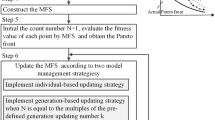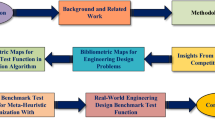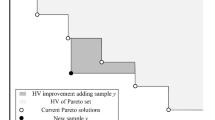Abstract
Multi-objective genetic algorithms (MOGAs) are effective ways for obtaining Pareto solutions of multi-objective design optimization problems. However, the high computational cost of MOGAs limits their applications to practical engineering optimization problems involving computational expensive simulations. To address this issue, a novel variable-fidelity (VF) optimization approach for multi-objective design optimization is proposed, in which a VF metamodel is embedded in the computation process of MOGA to replace the expensive simulation model. The VF metamodel is updated in the optimization process of MOGA, considering the cost of simulation models with different fidelity and the influence of the VF metamodel uncertainty. A normalized distance constraint is introduced to avoid selecting clustered sample points. Four numerical examples and two engineering cases are used to demonstrate the applicability and efficiency of the proposed approach. The results show that the proposed approach can obtain Pareto solutions with good quality and outperforms the other four approaches considered here as references in terms of computational efficiency.





















Similar content being viewed by others
Abbreviations
- C(x):
-
the difference between HF response and prediction value of LF metamodel at x
- \( \widehat{\boldsymbol{C}}\left(\boldsymbol{x}\right) \) :
-
the prediction value of the scaling function metamodel at x
- F Motor :
-
the weight of the engine in the front of the micro-aerial vehicle (N)
- F Payload :
-
the payload of the micro-aerial vehicle (N/mm2)
- F Tail :
-
the weight of the tail of the micro-aerial vehicle (N)
- f h :
-
vector of HF responses of given HF sample set
- f l :
-
vector of LF responses of given LF sample set
- f h(x):
-
the function value of HF model at x
- \( {\widehat{f}}_l\left(\boldsymbol{x}\right) \) :
-
the prediction value of LF metamodel at x
- \( {\widehat{f}}_{vf}\left(\boldsymbol{x}\right) \) :
-
the prediction value of VF metamodel at x
- I(x):
-
the prediction interval of VF metamodel at x
- P1, P2:
-
forces placed at the center of the right end of the torque arm (N)
- x l :
-
LF sample set
- x h :
-
HF sample set
- σ C(x):
-
the standard deviation of scaling function metamodel at x
- σ l(x):
-
the standard deviation of LF metamodel at x
- σ vf (x):
-
the standard deviation of VF metamodel at x
- h:
-
quantities associated with high fidelity
- l:
-
quantities associated with low fidelity
- vf:
-
quantities associated with variable fidelity
References
Ak R, Li Y, Vitelli V, Zio E, López Droguett E, Magno Couto Jacinto C (2013) NSGA-II-trained neural network approach to the estimation of prediction intervals of scale deposition rate in oil & gas equipment. Expert Syst Appl 40:1205–1212
An H, Chen S, Huang H (2018) Multi-objective optimization of a composite stiffened panel for hybrid design of stiffener layout and laminate stacking sequence. Struct Multidiscip Optim 57:1411–1426
Andrés E, Salcedo-Sanz S, Monge F, Pérez-Bellido AM (2012) Efficient aerodynamic design through evolutionary programming and support vector regression algorithms. Expert Syst Appl 39:10700–10708
Chen G, Han X, Liu G, Jiang C, Zhao Z (2012) An efficient multi-objective optimization method for black-box functions using sequential approximate technique. Appl Soft Comput 12:14–27
Cheng R, Jin Y, Narukawa K, Sendhoff B (2015a) A multiobjective evolutionary algorithm using Gaussian process-based inverse modeling. Evolutionary Computation, IEEE Transactions on 19:838–856
Cheng S, Zhou J, Li M (2015b) A new hybrid algorithm for multi-objective robust optimization with interval uncertainty. J Mech Des 137:021401
Datta R, Regis RG (2016) A surrogate-assisted evolution strategy for constrained multi-objective optimization. Expert Syst Appl 57:270–284
Deb K, Pratap A, Agarwal S, Meyarivan T (2002) A fast and elitist multiobjective genetic algorithm: NSGA-II. Evolutionary Computation, IEEE Transactions on 6:182–197
Gano SE, Renaud JE, Martin JD, Simpson TW (2006) Update strategies for kriging models used in variable fidelity optimization. Struct Multidiscip Optim 32:287–298
Goel T, Vaidyanathan R, Haftka RT, Shyy W, Queipo NV, Tucker K (2007) Response surface approximation of Pareto optimal front in multi-objective optimization. Comput Methods Appl Mech Eng 196:879–893
Hamdaoui M, Oujebbour F-Z, Habbal A, Breitkopf P, Villon P (2015) Kriging surrogates for evolutionary multi-objective optimization of CPU intensive sheet metal forming applications. Int J Mater Form 8:469–480
Han Z-H, Zimmermann R, Goretz S (2010) A new cokriging method for variable-Fidelity surrogate modeling of aerodynamic data. In: 48th AIAA aerospace sciences meeting including the new horizons forum and aerospace exposition. p 1225
Huang D, Allen TT, Notz WI, Miller RA (2006) Sequential kriging optimization using multiple-fidelity evaluations. Struct Multidiscip Optim 32:369–382
Koch P, Yang R-J, Gu L (2004) Design for six sigma through robust optimization. Struct Multidiscip Optim 26:235–248
Li M (2011) An improved kriging-assisted multi-objective genetic algorithm. J Mech Des 133:071008-071008-071011
Li G, Li M, Azarm S, Rambo J, Joshi Y (2007) Optimizing thermal design of data center cabinets with a new multi-objective genetic algorithm. Distributed and Parallel Databases 21:167–192
Li M, Li G, Azarm S (2008) A kriging metamodel assisted multi-objective genetic algorithm for design optimization. J Mech Des 130:031401
Li G, Li M, Azarm S, Al Hashimi S, Al Ameri T, Al Qasas N (2009) Improving multi-objective genetic algorithms with adaptive design of experiments and online metamodeling. Struct Multidiscip Optim 37:447–461
Liu Y, Collette M (2014) Improving surrogate-assisted variable fidelity multi-objective optimization using a clustering algorithm. Appl Soft Comput 24:482–493
Luo J, Gupta A, Ong Y-S, Wang Z (2018) Evolutionary optimization of expensive multiobjective problems with co-sub-Pareto front Gaussian process surrogates. IEEE Transactions on Cybernetics
McKay MD, Beckman RJ, Conover WJ (2000) A comparison of three methods for selecting values of input variables in the analysis of output from a computer code. Technometrics 42:55–61
Nguyen J, Park SI, Rosen D (2013) Heuristic optimization method for cellular structure design of light weight components. Int J Precis Eng Manuf 14:1071–1078
Ollar J, Mortished C, Jones R, Sienz J, Toropov V (2017) Gradient based hyper-parameter optimisation for well conditioned kriging metamodels. Struct Multidiscip Optim 55:2029–2044
Park H-S, Dang X-P (2010) Structural optimization based on CAD–CAE integration and metamodeling techniques. Comput Aided Des 42:889–902
Rahmani S, Ebrahimi M, Honaramooz AA (2018) Surrogate-based optimization using polynomial response surface in collaboration with population-based evolutionary algorithm. In: Schumacher A, Vietor T, Fiebig S, Bletzinger K-U, Maute K (eds) Advances in Structural and Multidisciplinary Optimization. Springer International Publishing, Cham, pp 269–280
Regis RG (2014) Evolutionary programming for high-dimensional constrained expensive black-box optimization using radial basis functions. Evolutionary Computation, IEEE Transactions on 18:326–347
Shan S, Wang GG (2005) An efficient Pareto set identification approach for multiobjective optimization on black-box functions. J Mech Des 127:866–874
Shi Y, Reitz RD (2010) Assessment of multiobjective genetic algorithms with different niching strategies and regression methods for engine optimization and design. J Eng Gas Turbines Power 132:052801
Shu L, Jiang P, Wan L, Zhou Q, Shao X, Zhang Y (2017) Metamodel-based design optimization employing a novel sequential sampling strategy. Eng Comput 34:2547–2564
Shu L, Jiang P, Zhou Q, Shao X, Hu J, Meng X (2018) An on-line variable fidelity metamodel assisted multi-objective genetic algorithm for engineering design optimization. Appl Soft Comput 66:438–448
Song Z, Murray BT, Sammakia B, Lu S (2012) Multi-objective optimization of temperature distributions using artificial neural networks. In: Thermal and Thermomechanical Phenomena in Electronic Systems (ITherm), 2012 13th IEEE intersociety conference on. IEEE, pp 1209–1218
Sun X, Gong D, Jin Y, Chen S (2013) A new surrogate-assisted interactive genetic algorithm with weighted semisupervised learning. Cybernetics, IEEE Transactions on 43:685–698
Sun C, Jin Y, Cheng R, Ding J, Zeng J (2017) Surrogate-assisted cooperative swarm optimization of high-dimensional expensive problems. IEEE Trans Evol Comput 21:644–660
Wang H, Jin Y, Jansen JO (2016) Data-driven surrogate-assisted multiobjective evolutionary optimization of a trauma system. IEEE Trans Evol Comput 20:939–952
Wu J, Azarm S (2001) Metrics for quality assessment of a multiobjective design optimization solution set. J Mech Des 123:18–25
Zhou Q, Shao X, Jiang P, Cao L, Zhou H, Shu L (2015) Differing mapping using ensemble of metamodels for global variable-fidelity metamodeling. Comput Model Eng Sci 106:323–355
Zhou Q, Wang Y, Choi S-K, Jiang P, Shao X, Hu J (2017) A sequential multi-fidelity metamodeling approach for data regression. Knowl-Based Syst 134:199–212
Zhu J, Wang Y-J, Collette M (2013) A multi-objective variable-fidelity optimization method for genetic algorithms. Eng Optim 46:521–542
Acknowledgments
The authors also would like to thank the anonymous referees for their valuable comments.
Funding
This research has been supported by the National Natural Science Foundation of China (NSFC) under Grant No. 51775203, No. 51805179, No. 51721092, and the Fundamental Research Funds for the Central Universities, HUST: Grant No. 2016YXMS272.
Author information
Authors and Affiliations
Corresponding author
Ethics declarations
Conflict of interest
The authors declare that they have no conflict of interest.
Additional information
Responsible Editor: Shapour Azarm
Publisher’s note
Springer Nature remains neutral with regard to jurisdictional claims in published maps and institutional affiliations.
Rights and permissions
About this article
Cite this article
Shu, L., Jiang, P., Zhou, Q. et al. An online variable-fidelity optimization approach for multi-objective design optimization. Struct Multidisc Optim 60, 1059–1077 (2019). https://doi.org/10.1007/s00158-019-02256-0
Received:
Revised:
Accepted:
Published:
Issue Date:
DOI: https://doi.org/10.1007/s00158-019-02256-0




